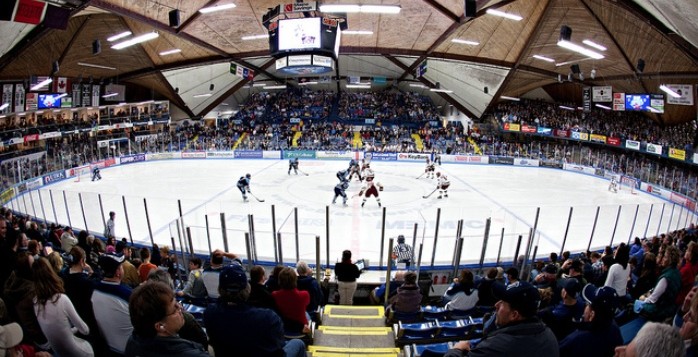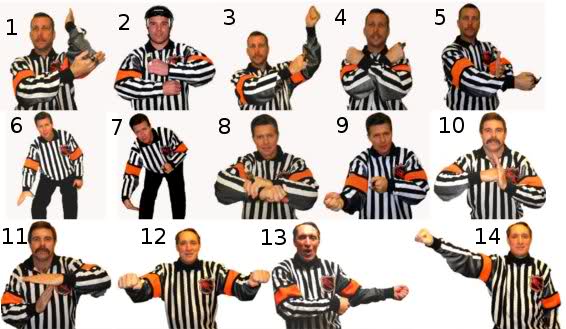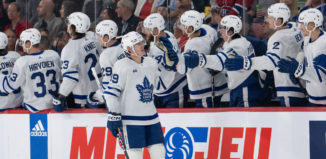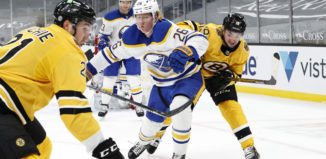Learning the game, just like you: Infractions & Penalties
By Ariel Carron
Hey gang, we’re back! After a longer than anticipated break, the Learning the game segment is back and ready for action. This time, we’re taking on a much loved topic –Infractions & Penalties. For those pink puck-ers who have missed this segment and want to learn more about hockey, we’ve also discussed topics such as: the rink, the net, the puck, and team positions. Since I’m still newer to hockey, we’re learning together!
As always, we’re going to use our handy-dandy “A to Z Guide to Hockey Terms” by Tim Moshansky to help us learn about penalties and infractions.
Penalty – When rules are broken, which are determined by a referee, and lead to a set time off the ice. The time served for the infraction is determined by the penalty type.
Major Penalty – A major penalty is a penalty that is served for five-minutes long. Even if the other team scores the player must stay in the box for the full five-minutes.
Bench Minor – This is a penalty against the coach or a player who isn’t on the ice.
Boarding – As with many terms in hockey, boarding is much like its name suggests. It is when one player body-checks another player and they are thrown against the boards. This is a minor penalty.
Butt-ending – This term sounds funnier than it really is and does not have anything to do with a butt at all. In fact, it has to do with the last three inches of the stick. When this is jabbed into another player it’s called “butt-ending” and is either a double minor penalty or a major penalty.
Charging – This is when a player either takes three strides or leaves their feet to hit an opposing player, which is considered a minor penalty.
Cross-checking – Considered a minor penalty, cross-checking is when a player holds their stick across their checks, pushes out, and strikes another player with the stick shaft.
Clipping – To make this super simple–this is when one player trips another.
Delay of Game – When a player intentionally causes the game to stop play, for example, knocking the net over. This is considered a minor penalty.
Delayed penalty – This is when a referee signals a penalty, but play is not stopped until either a goal is scored or the offending team touches the puck. If a goal is scored by the non-offending team, the penalty is waived.
Diving –This qualifies as “unsportsmanlike conduct,” which we will discuss a little later, but diving is when a player makes contact with another player and then exaggerates the movement to look like a penalty has been committed. It is considered a minor penalty.
Double Minor – Essentially, when a player is called for two two-minute penalties at the same exact time.
Draw a penalty – I think Moshansky’s words are best to describe this, saying, “When a players speed, agility, or power causes an opposing player to commit a foul against that player in an attempt to check him.”
Elbowing – As the name implies, elbowing is when players jab or throw their elbows into their opponent. If seen, this can result in a two-minute penalty.
Falling on the Puck – This is when a player uses his or her body to deliberately cover the puck.
Fighting – In most cultures, you get past the age of four and know what this means. When it pertains to hockey, it means when a player engages in “fisticuffs” or “boxing.” For both players involved this can result in a five-minute penalty.
Game Misconduct – When a player commits an outrageous and offensive act, typically with the intent to injure an opposing player or official, they are sent to their locker room and removed from the game.
Goaltender Interference – Honestly, I’m going to throw the definition of this one off the professionals. It gets complicated so, you can read all about it here on the NHL Website.
High Sticking – This is when a player touches the puck or another player by swinging their stick above their shoulders. Often, if there is visible blood or damage on a player than there will be a double minor issued.
Holding –If one player grabs another and doesn’t let go within three seconds, this is considered holding and a minor penalty.
Interference – Essentially, this is when one player impedes an opposing player who does not have possession of the puck. This is considered a minor penalty.
Kneeing – Like elbowing, the name refers to the action. This is when one player hits another with their knee.
Major Penalty – A five minute penalty issued to a player where they have to say in the box for this amount of time. There are several assorted major penalties, you can find more information listed here.
Match Penalty – From my eyes, this is pretty bad penalty. It’s when a player commits an infraction that is very vindictive or malicious. A player is thrown out of the game and another from their team is chosen to serve a five-minute penalty in the box.
Minor Penalty – Simply put, a two minute long penalty.
Obstruction – This is when one player hinders an opposing player by slashing, holding, elbowing, hooking, etc. It’s considered a minor penalty.
Playing with a Broken Stick – Another more obvious term, this is when a player plays with a broken stick and in turn creates a dangerous situation for other players. it is considered a minor penalty.
Roughing – This is when one player manhandles or gets in a fight with another player. It’s considered a minor penalty.
Slashing – When one player swings their stick at another player, they’ll usually get a minor penalty.
Spearing – So, this is when one player jabs the blade of their stick into another player and can be considered a major or a minor penalty, depending on the action.
Third Man In – When two players on opposing teams are fighting and another player steps in to help their teammate, this is called a third man in and is considered a minor penalty.
Too Many Men – I thought this one would have to do with “third man in,” but I was wrong. It actually is when one team has too many players on the ice with possession of the puck. It’s considered a minor penalty.
Tripping – This is when one player used either his stick or body to knock the legs of an opposing player typically resulting in a fall or “tripping.” It is considered a minor penalty.
Unsportsmanlike Conduct – There are several instances when a referee determines Unsportsmanlike Conduct. The first is if they use swear or use abusive language towards other players or a referee. The second is when a player throws equipment outside of the rink or knocks the puck away from a ref. Lastly, is when a player challenges or argues a referee’s call or decision. All of these result in a two-minute penalty.
If you’re looking for more information regarding penalties and infractions feel free to skate on over to the NHL Website for more details. I’ve just provided the basics to Infractions & Penalties here, but there really is so much more to it. Once again, thank you Pink Puck-ers for your continued support. I’m looking forward to spreading more hockey terms and knowledge!
Note: Hey guys, since I’m just learning, if you think I’ve missed something give me a shout out! Or, if you want to know more term information and think I should write an article about it–let me know. I’ve provided a way to get in contact with me above and would love to hear from you. Thanks so much for your support.
References:
Moshansky, T. (2010). A to z guide to hockey terms (2nd ed.). Vancouver, BC: First Wave Publishing.















